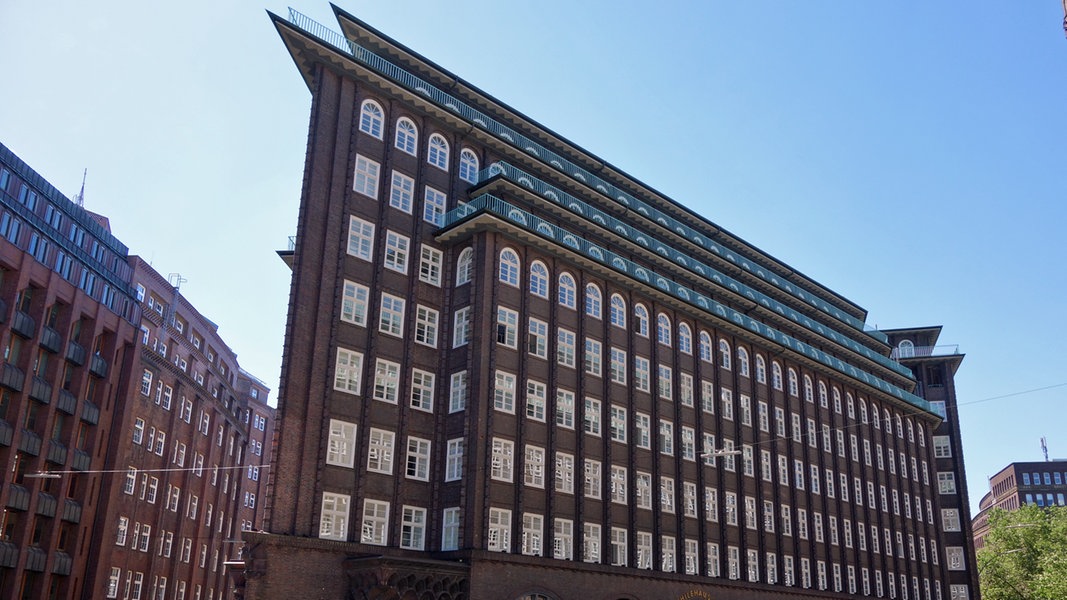As of: April 1, 2024 12:52 p.m
Its shape is reminiscent of a ship: Hamburg’s Chilehaus is one of the most important buildings of brick expressionism and is a UNESCO World Heritage Site. The huge office building was opened on April 1, 1924.
The ten-story building looks particularly impressive when the visitor approaches from the southeast. The clinker brick building rises into the sky like a huge, pointed ship’s bow; the entire outer facade with its 2,800 windows is curved. Since July 2015, the Chilehaus has been part of the Kontorhausviertel and, together with the neighboring Speicherstadt, one of Hamburg’s world cultural heritage sites.
Center of the Kontorhaus district
The interior of the Chilehaus is no less impressive: heavy mahogany doors, winding staircases and ceramic ornaments adorn the enormous building, which is grouped around a rectangular courtyard. The Chilehaus is the best-known building in the Kontorhausviertel, where numerous large brick complexes were built from the 1920s onwards that served as office buildings. This includes the Sprinkenhof, which is right next door.
4.8 million bricks and 750 freight cars of cement
Along with Fritz Schumacher, architect Fritz Höger is considered the most important representative of North German brick expressionism. He had 4.8 million bricks and 750 freight cars of cement used for the huge office building, which he built on behalf of the Hamburg merchant Henry Brarens Sloman.
The client became rich through overseas trade with Chile
Sloman left Hamburg as a young man for Chile and later became rich through the saltpeter trade. In 1898, at the age of 50, he returned to his hometown and later commissioned the largest office building in Germany at the time, measuring 36,000 square meters.
Building rests on concrete piles
Höger had to submit 17 building applications before the Senate approved the building, which was built on two properties with a total area of almost 6,000 square meters. The plan to build over Fischertwiete Street was initially met with skepticism. Because the building was built on damp ground, concrete piles were used in the foundation, and cellars and boiler rooms were specially protected from flooding due to their proximity to the Elbe. Because of its spectacular architecture, the building soon gained worldwide attention. After its completion in 1924, mainly small and medium-sized import and export companies that were active in overseas trade settled in the office building.
The inner courtyard and staircase are open to visitors
Today the building is home to medical practices, law firms and a number of office spaces, especially for smaller companies. Restaurants, a department store and several smaller retailers are located on the ground floor around the inner courtyard. Visitors can only get an impression of the impressive building from the outside and by visiting the inner courtyard and the stairwells. The interior office spaces are generally not open to the public. The Chilehaus has been a listed building since 1983.
Keyword: Brick Expressionism
In the 1920s, a variant of expressionist architecture developed in which clinker or brick was the focus of the facade design. An ornamental design language with some angular or pointed elements is characteristic. The brick is specifically set into patterns and makes the facade appear particularly lively. Numerous buildings in the brick expressionist style were built, especially in northern Germany and the Rhine-Ruhr area.
Map: Chilehaus, Kontorhausviertel and Speicherstadt
World Heritage in the North
ARD media library
100 years of weather have taken their toll on the red brick. How can Hamburg’s cityscape be saved? Video
3 Min
Shopping, museums and architecture – the student Florian shows Martin from Gut Moor through his district. 3 mins
The warehouse complex and the imposing brick building of the Chilehaus are just a stone’s throw from Hafencity. more
This topic in the program:
Hamburg Journal | 12/10/2023 | 19:30 o’clock
